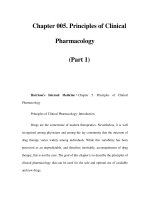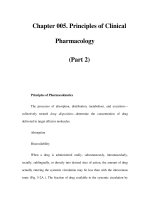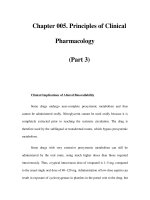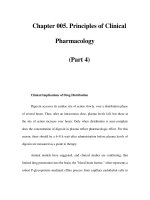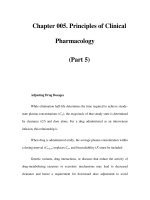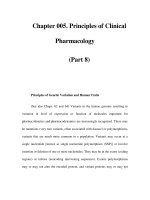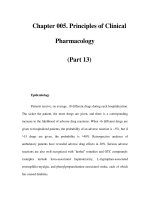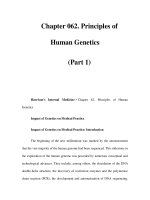Chapter 062. Principles of Human Genetics (Part 8) docx
Bạn đang xem bản rút gọn của tài liệu. Xem và tải ngay bản đầy đủ của tài liệu tại đây (49.74 KB, 5 trang )
Chapter 062. Principles of
Human Genetics
(Part 8)
Transcriptional activation can be divided into three main mechanisms:
1. Events that alter chromatin structure can enhance the access
of transcription factors to DNA. For example, histone acetylation generally
opens chromatin structure and is correlated with transcriptional activation.
2. Posttranslational modifications of transcription factors, such
as phosphorylation, can induce the assembly of active transcription
complexes. As an example, phosphorylation of CREB protein on serine 133
induces a conformational change that allows the recruitment of CREB-
binding protein (CBP), a factor that integrates the actions of many
transcription factors, including proteins, with histone acetyltransferase
activity.
3. Transcriptional activators can displace a repressor protein.
This mechanism is particularly common during development when the
pattern of transcription factor expression changes dynamically.
Of course, these mechanisms are not mutually exclusive, and most genes
are activated by some combination of these events.
Suppression of gene expression is as important as gene activation in the
control of cell differentiation and function. Some mechanisms of repression are the
corollary of activation. For example, repression is often associated with histone
deacetylation or protein dephosphorylation. For nuclear hormone receptors,
transcriptional silencing involves the recruitment of repression complexes that
contain histone deacetylase activity. Aberrant expression of repressor proteins is
sometimes associated with neoplasia. The t(15;17) chromosomal translocation that
occurs in promyelocytic leukemia fuses the PML gene to a portion of the retinoic
acid receptor α (RAR α) gene (Table 62-2). This event causes unregulated
transcriptional repression in a manner that precludes normal cellular
differentiation. The addition of the RAR ligand, retinoic acid, activates the
receptor, thereby relieving repression and allowing cells to differentiate and
ultimately undergo apoptosis. This mechanism has therapeutic importance as the
addition of retinoic acid to treatment regimens induces a higher remission rate in
patients with promyelocytic leukemia (Chap. 104). Methylation of promoter
regions is frequently found in neoplasms and silences gene expression.
Cloning and Sequencing DNA
A description of recombinant DNA techniques, the methodology used for
the manipulation, analysis, and characterization of DNA segments, is beyond the
scope of this chapter. As these methods are widely used in genetics and molecular
diagnostics, however, it is useful to review briefly some of the fundamental
principles of cloning and DNA sequencing.
Cloning of Genes
Cloning refers to the creation of a recombinant DNA molecule that can be
propagated indefinitely. The ability to clone genes and cDNAs therefore provides
a permanent and renewable source of these reagents. Cloning is essential for DNA
sequencing, nucleic acid hybridization studies, expression of recombinant
proteins, and other recombinant DNA procedures.
The cloning of DNA involves the insertion of a DNA fragment into a
cloning vector, followed by the propagation of the recombinant DNA in a host
cell. The most straightforward cloning strategy involves inserting a DNA fragment
into bacterial plasmids. Plasmids are small, autonomously replicating, circular
DNA molecules that propagate separately from the chromosome in bacterial cells.
The process of DNA insertion relies heavily on the use of restriction enzymes,
which cleave DNA at highly specific sequences (usually 4–6 bp in length).
Restriction enzymes generate complementary, cohesive sequences at the ends of
the DNA fragment, which allow them to be efficiently ligated to the plasmid
vector. Because plasmids contain genes that confer resistance to antibiotics, their
presence in the host cell can be used for selection and DNA amplification.
A variety of vectors (e.g., plasmids, phage, bacterial, or yeast artificial
chromosomes) are used for cloning. Many of these are used for creating libraries,
a term that refers to a collection of DNA clones. A genomic library represents an
array of clones derived from genomic DNA. These overlapping DNA fragments
represent the entire genome and can ultimately be arranged according to their
linear order. cDNA libraries reflect clones derived from mRNA, typically from a
particular tissue source. Thus, a cDNA library from the heart contains copies of
mRNA expressed specifically in cardiac myocytes, in addition to those that are
expressed ubiquitously. For this reason, a heart cDNA library will be enriched
with cardiac-specific gene products and will differ from cDNA libraries generated
from liver or pituitary mRNAs. As an example of the complexity of a genomic
library, consider that the human genome contains 3 x 10
9
bp and the average
genomic insert in a λ phage library is ~10
4
bp. Therefore, it requires at least 3 x
10
5
clones to represent all genomic DNA. Specific clones are isolated from the
several hundred thousand clones by using DNA hybridization.
With completion of the HGP, all human genes have been cloned and
sequenced. As a result, many of these cloning procedures are now unnecessary or
greatly facilitated by the extensive information concerning DNA markers and the
sequence of DNA (see below).

